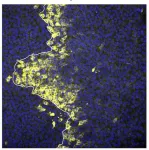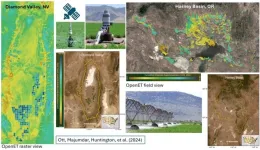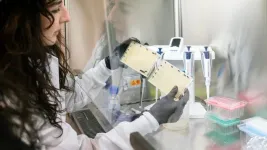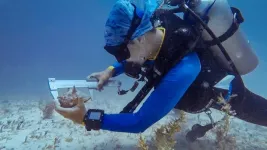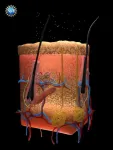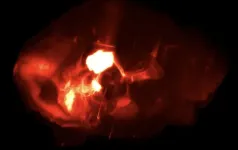(Press-News.org) How would you summarize your study for a lay audience?
Immune checkpoint inhibitors (ICIs) are a class of immunotherapy that have revolutionized the treatment of cancer. However, they can cause a wide variety of autoimmune toxicities, including immune checkpoint inhibitor-associated acute kidney injury (ICI-AKI). Differentiating ICI-AKI from acute kidney injury (AKI) due to alternative causes, which are common in cancer patients, is challenging without a kidney biopsy due to the risk of bleeding for some patients.
In this study, we examined whether F18-FDG PET-CTs, a type of nuclear imaging study, could be used to distinguish patients with ICI-AKI from those with AKI from alternative causes. We found that patients with ICI-AKI had much higher levels of radioactively-labeled glucose in the kidneys, indicating kidney inflammation, compared to patients with AKI from non-ICI causes. These findings indicate that this type of radiographic scan could be a non-invasive alternative to kidney biopsy for diagnosing ICI-AKI.
What knowledge gaps does your study help to fill?
Previous research has demonstrated that the most common finding from kidney biopsies in patients with ICI-AKI is acute interstitial nephritis, or inflammation in the kidney as a result of activated T-cells. To diagnose this condition in current practice, patients must undergo a kidney biopsy. However, patients may have contraindications (e.g., they may have only one kidney or they may be receiving treatment with blood thinners), preventing them from proceeding safely with a kidney biopsy. Thus, non-invasive markers are greatly needed to diagnose ICI-AKI.
Case reports and smaller studies had explored the utility of F18-FDG PET-CT scans as a non-invasive option for diagnosing ICI-AKI, but those studies had significant limitations, including small sample size, lack of clear inclusion and exclusion criteria, and lack of a control group. In this study, we sought to address these limitations and investigate the utility of F18-FDG PET-CTs as way to non-invasively diagnose ICI-AKI.
How did you conduct your study?
Using data from our previous multi-center study of patients with ICI-AKI, we focused on those who had a F18-FDG PET-CT scan around the time of ICI-AKI diagnosis. We also included 2 control groups: patients with AKI from non-ICI etiologies and patients treated with ICIs who did not have AKI at the time of a follow-up F18-FDG PET-CT. For all three groups, patients were included if they had F18-FDG PET-CTs scans at baseline and within 14 days of AKI onset (or, for the second control group, a follow-up scan between 90-365 days following ICI initiation).
Nuclear radiologists reviewed the F18-FDG PET-CTs at baseline and follow-up and recorded the average radiotracer standardized uptake value (SUV) in the renal cortices. The SUV quantifies the amount of radioactively-labeled glucose in the kidneys, serving as a marker of the amount of inflammation and metabolic activity occurring in the kidneys.
We then calculated the average percent change in SUV from baseline to follow-up for each patient. The SUV mean increased by a median of 57.4% from baseline to follow-up among patients with ICI-AKI, whereas it only increased by 8.5% among patients with AKI from non-ICI causes and was unchanged in patients receiving ICIs without AKI.
What are the implications?
Our findings suggest that F18-FDG PET-CTs may be a useful test for diagnosing ICI-AKI. Our hope is to offer patients who can't undergo a kidney biopsy safely a non-invasive testing option, such as with F18-FDG PET-CTs scans, to differentiate the cause of AKI as being ICI-related vs. non-ICI-related. This has important implications for patients, because those with ICI-AKI are treated promptly with steroids, and their ICI therapy is typically held until their AKI has recovered or at least stabilized.
What are the next steps?
The next step is to validate our findings in a larger prospective study where we recruit patients who have AKI while on ICI treatment to see if F18-FDG PET-CTs can definitively differentiate ICI-AKI from AKI from non-ICI causes.
Authorship: In addition to Leaf and Gupta, Mass General Brigham authors include Olivia Green-Lingren (co-first author), Sudhir Bhimaniya (co-first author), Aleksandra Krokmal, Heather Jacene, Sophia L. Wells, Sarah A. Kaunfer, Jessica L. Ortega, Sujal I. Shah, Michael Weintraub, Raad B. Chowdhury, Meghan E. Sise, Pedram Heidari, Meghan D. Lee, Harish Seethapathy and Kerry Reynolds. Additional authors include Marlies Ostermann, Sugama Chicklore, Ben Sprangers, Christophe M. Deroose, Sandra M. Herrman, Clara Garcia Carro, Michael Bold, Kevin L. Chen, Wai Lun Will Pak, Pazit Beckerman, Yael Eshet, Raymond K. Hsu, Miguel Hernandez Pampaloni, Arash Rashidi, Norbert Avril, Vicki Donley, Zain Mithani, Russ Kuker, Muhammad Awiwi, Mindy Wang, Heiko Schoder, Harish Seethapathy, Kerry Reynolds, Maria Jose Soler, Ala Abudayyeh and Ilya Glezerman.
Funding:
Disclosures:
Paper cited: Gupta S et al. “F18-FDG PET imaging as a diagnostic tool for immune checkpoint inhibitor-associated acute kidney injury.” The Journal of Clinical Investigation DOI: 10.1172/JCI182275
END
Research spotlight: Radiology test can be used to diagnose immune checkpoint inhibitor-associated acute kidney injury
2024-09-05
ELSE PRESS RELEASES FROM THIS DATE:
Rice’s Aryeh Warmflash awarded $1.6M NIH grant for research on early human development
2024-09-05
Researchers at Rice University are working to understand how a single cell evolves into the complex network of specialized cells that form the human body. Funded by a $1.6 million grant from the National Institutes of Health, the research team’s new study could advance our knowledge of developmental disorders and contribute to the future of regenerative medicine.
Led byAryeh Warmflash, an associate professor of biosciences and Cancer Prevention and Research Institute of Texas Scholar in cancer ...
Researchers make mouse skin transparent using a common food dye
2024-09-05
Seeing what’s going on inside a body is never easy. While technologies like CT scans, X-rays, MRIs, and microscopy can provide insights, the images are rarely completely clear and can come with side effects like radiation exposure.
But what if you could apply a substance on the skin, much like a moisturizing cream, and make it transparent, without harming the tissue?
That’s what Stanford scientists have done using an FDA-approved dye that is commonly found in food, among several other light-absorbing molecules that exhibit similar effects. Published in Science on ...
Groundwater use can be accurately monitored with satellites using OPENet, new study finds
2024-09-05
Drought is a widespread concern in the Western U.S., and water managers across the region are developing groundwater management plans to conserve the essential resource. Groundwater is often pumped to the surface to irrigate crops, and meters that measure the flow of pumped water have historically offered the best information on groundwater use. These meters are rare, however, so DRI scientists set out to determine whether OpenET, a platform that measures evapotranspiration using satellite data, could help fill this information gap.
The new study, published August 8th in a special issue of Agricultural Water Management, compared groundwater meter ...
New technology could lead to alternative treatments for antibiotic-resistant bacteria
2024-09-05
SAN FRANCISCO—As antibiotic resistance becomes an increasingly serious threat to our health, the scientific and medical communities are searching for new medicines to fight infections. Researchers at Gladstone Institutes have just moved closer to that goal with a novel technique for harnessing the power of bacteriophages.
Bacteriophages, or phages for short, are viruses that naturally take over and kill bacteria. Thousands of phages exist, but using them as treatments to fight specific bacteria has so far proven to be challenging. To optimize phage therapy and make it scalable to human disease, scientists need ways to engineer phages into efficient bacteria-killing machines. This would ...
Research shows queen conch populations in marine reserves replenish populations beyond the reserve in The Bahamas
2024-09-05
A new study published in Conservation Science and Practice uncovers how breeding populations of queen conch (Aliger gigas) within a protected marine reserve, where fishing is prohibited, sustain populations beyond the borders of the reserve. This research, based on surveys conducted in The Bahamas by Shedd Aquarium and Bahamian partners, identifies where additional protections could help to ensure the survival of future queen conch generations.
In The Bahamas, queen conch is an economic and cultural ...
Worcester Polytechnic Institute launches nation's first master’s program in explosion protection engineering
2024-09-05
Worcester, MA – September 5, 2024—Worcester Polytechnic Institute (WPI) has launched a groundbreaking Master of Science in Explosion Protection Engineering, the first program of its kind in the United States. Designed amid growing concerns about fire and explosion risk posed by manufacturing facilities and advancing technologies like electric vehicles and hydrogen fuel cells, the new program builds on WPI’s esteemed legacy in Fire Protection Engineering, which has been at the forefront of fire safety education and research since its inception in 1978.
“The demand ...
UC Irvine, USC scientists begin research effort for damaged brain region treatments
2024-09-05
Irvine, Calif., Sept. 5, 2024 — With newly awarded funding from the National Science Foundation, researchers at the University of California, Irvine and the Keck School of Medicine of USC will seek to revolutionize the treatment of neurological diseases through intelligent biocomputing. The four-year, $2 million grant is part of NSF’s Emerging Frontiers in Research and Innovation program, which funds cutting-edge science pushing the boundaries of human knowledge.
The premise of the UC Irvine-USC project is to combine engineering principles with stem cell research to treat damaged brain regions. The team’s long-term goal is to restore motor functions to patients ...
Risky combos of psychiatric drugs prescribed for young patients
2024-09-05
A new study reveals that young patients treated with psychiatric medications receive potentially dangerous combinations with concerning frequency.
Researchers from Rutgers Health and other institutions analyzed New York State Medicaid records for more than 141,000 patients receiving any psychiatric medication. Nearly 400 of them received at least one potentially dangerous combination t for one month or longer. Doctors refer to these as severe drug-drug interactions, and their use is typically considered "contraindicated" or recommended ...
A window into the body: groundbreaking technique makes skin invisible
2024-09-05
Images, animations, and video available in our NSF portal:
https://nsf.widencollective.com/portals/ematkiby/TheInvisibleMouseEmbargoed
Access Code: Le9ANH7tYTdr
Researchers have developed a new way to see organs within a body by rendering overlying tissues transparent to visible light.
The counterintuitive process—a topical application of food-safe dye—was reversible in tests with animal subjects, and may ultimately apply to a wide range of medical diagnostics, from locating injuries to monitoring digestive disorders to identifying cancers.
Stanford University researchers published the research ″Achieving optical ...
Serotonin to bounce back from adversity
2024-09-05
The simple act of observing others cope with a traumatic experience can increase our capacity for resilience and prevent the pathological states that can result from it, notably depression. Neuroscientists at UNIL have demonstrated the presence of this “emotional contagion” in mice, and successfully deciphered its mechanism. The neurotransmitter serotonin, released in a brain structure called the habenula, has been shown to be the key to resilience. This discovery, published in Science, revisits the role of serotonin ...
